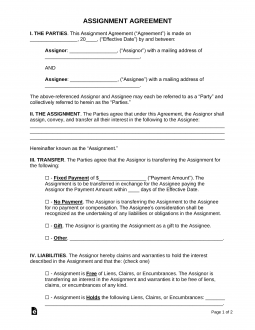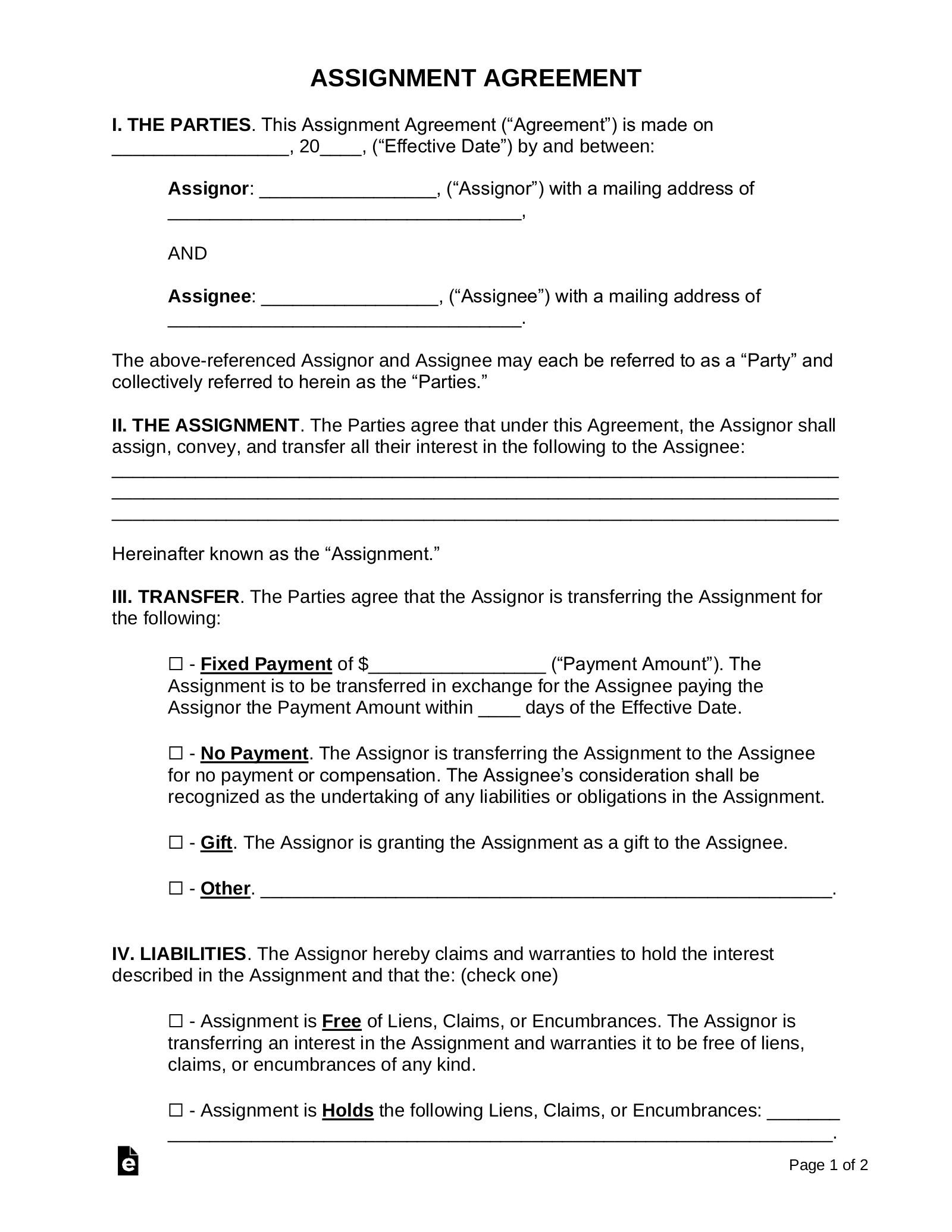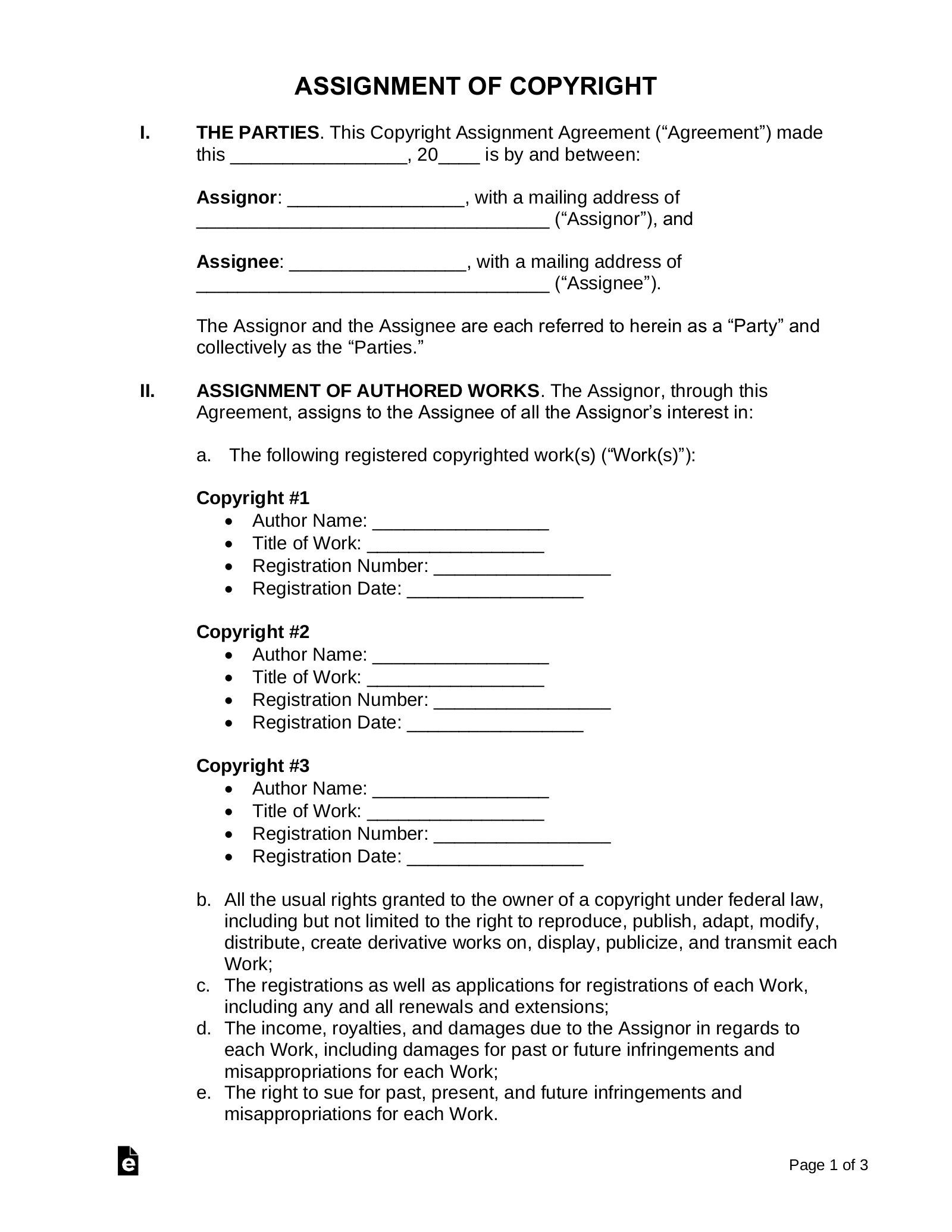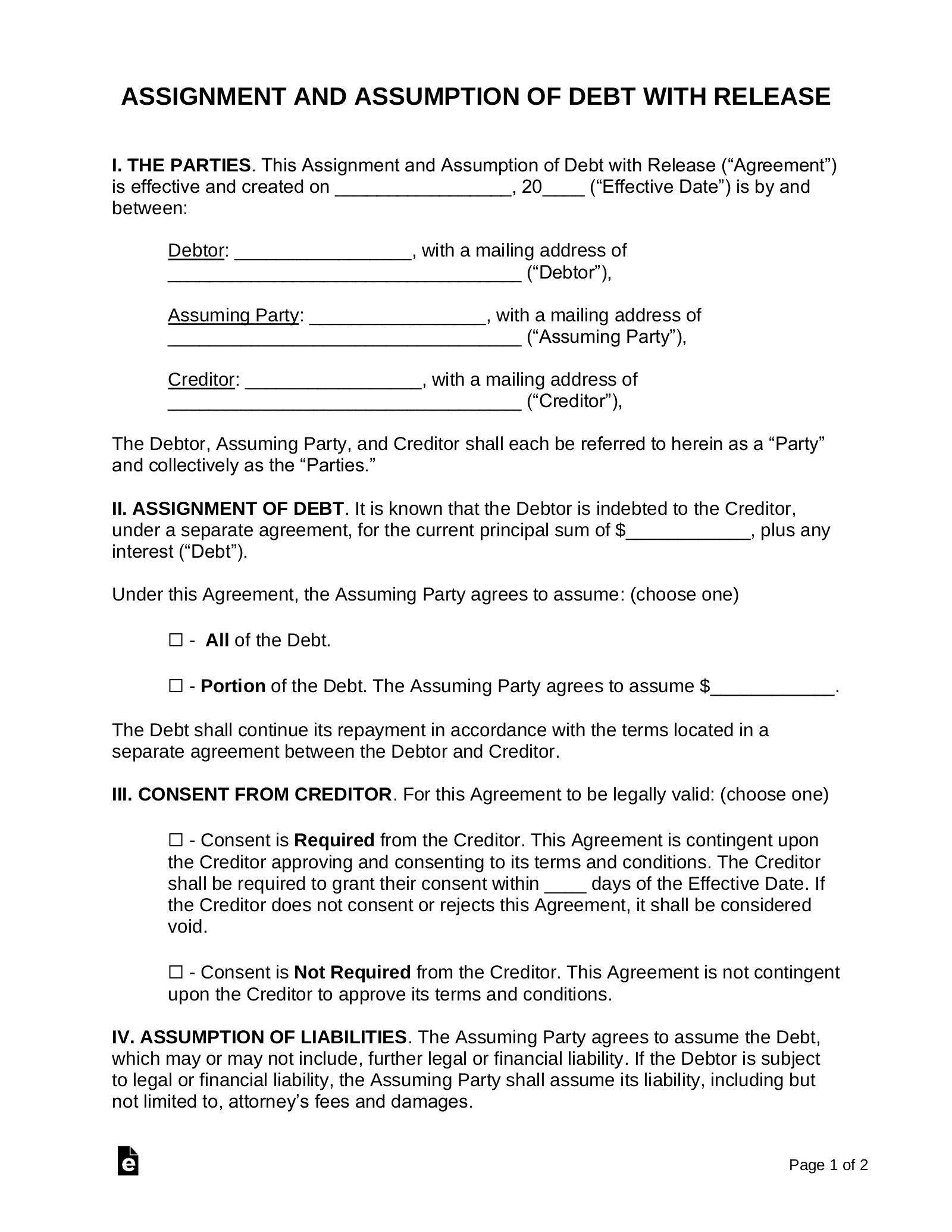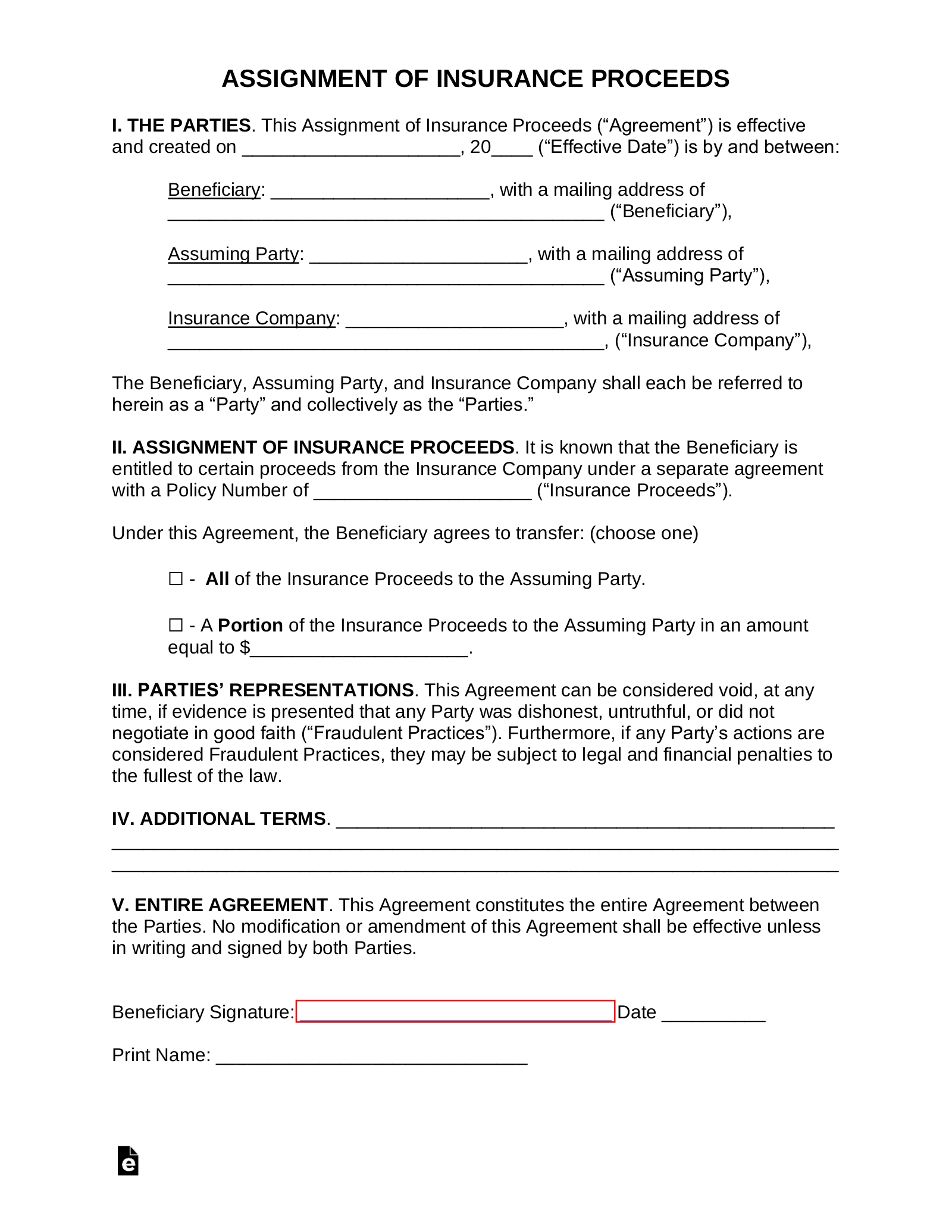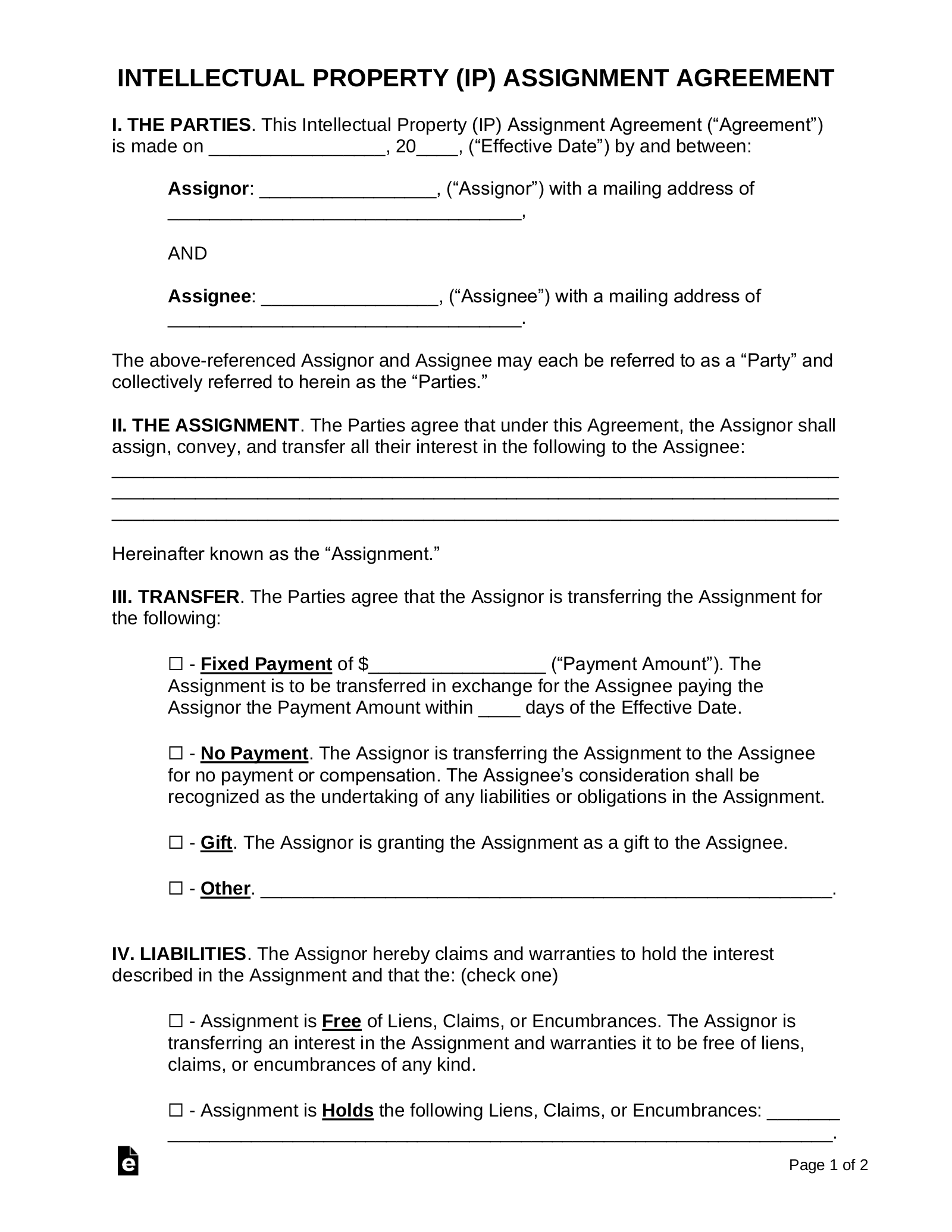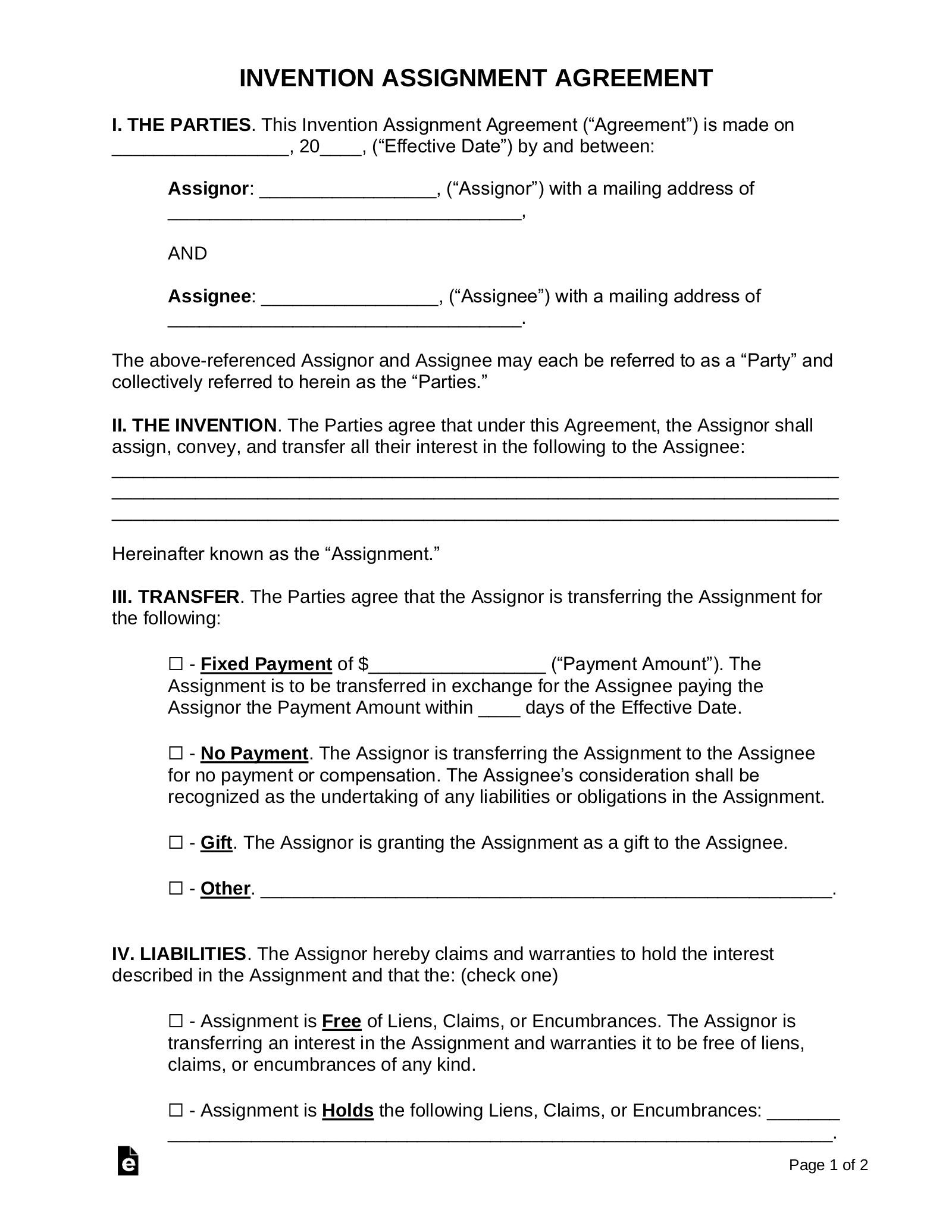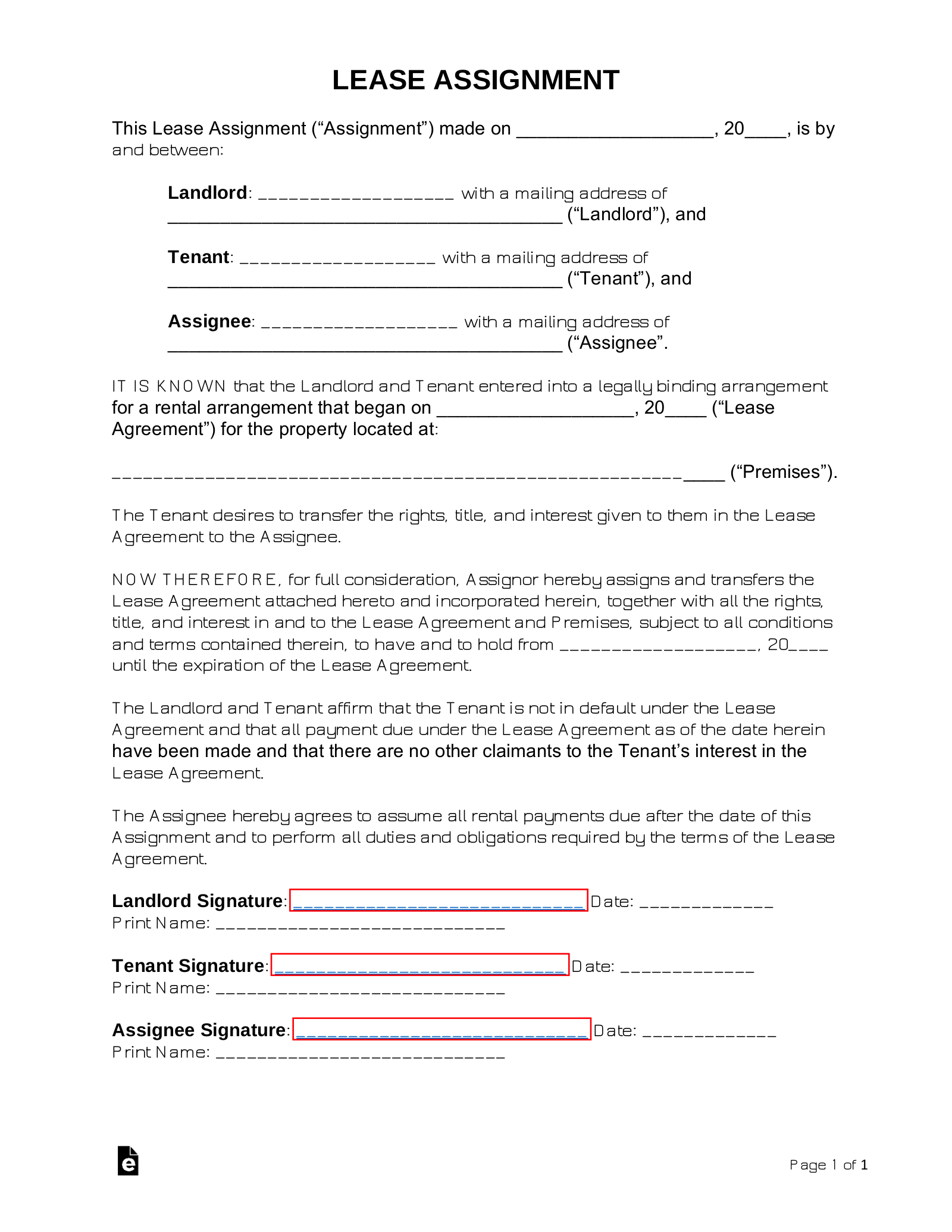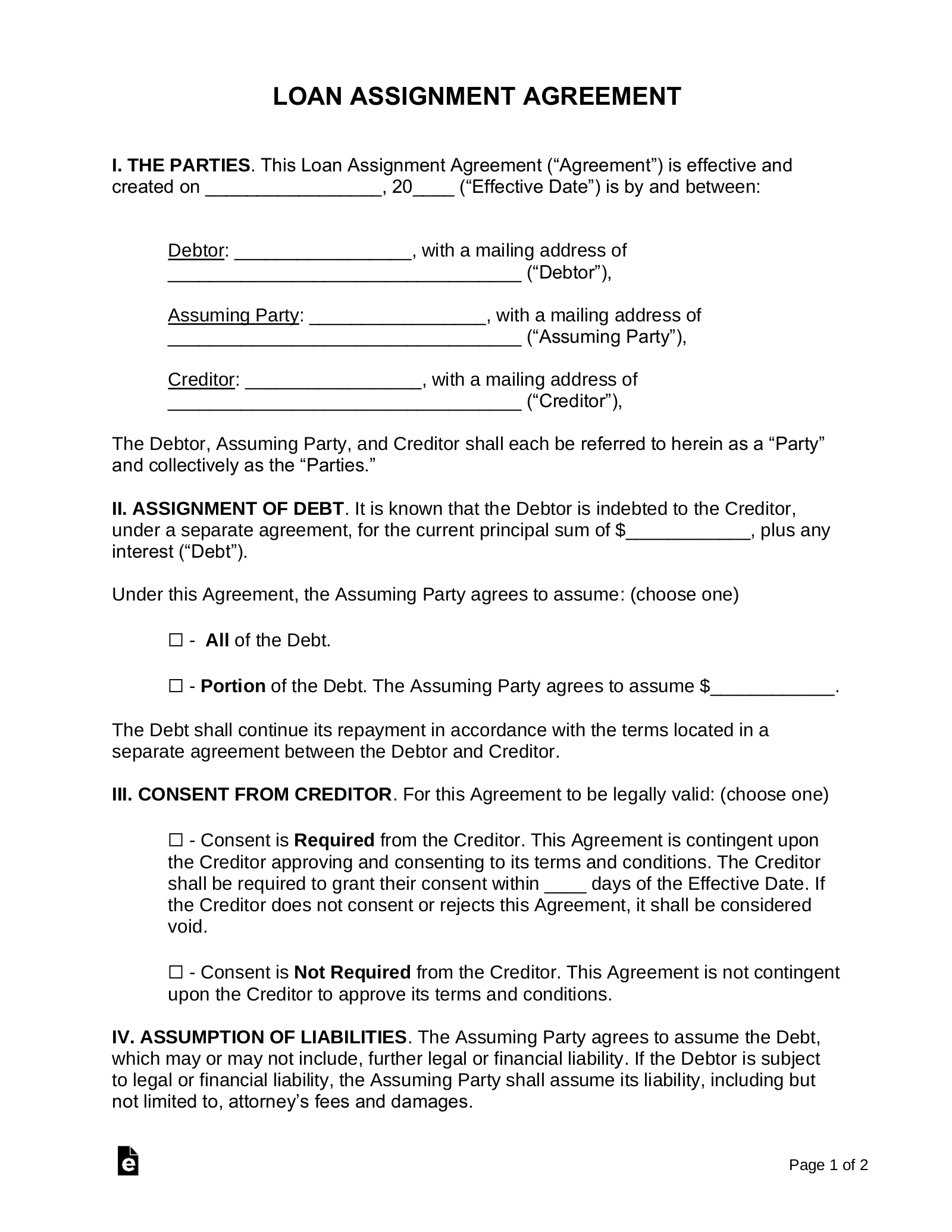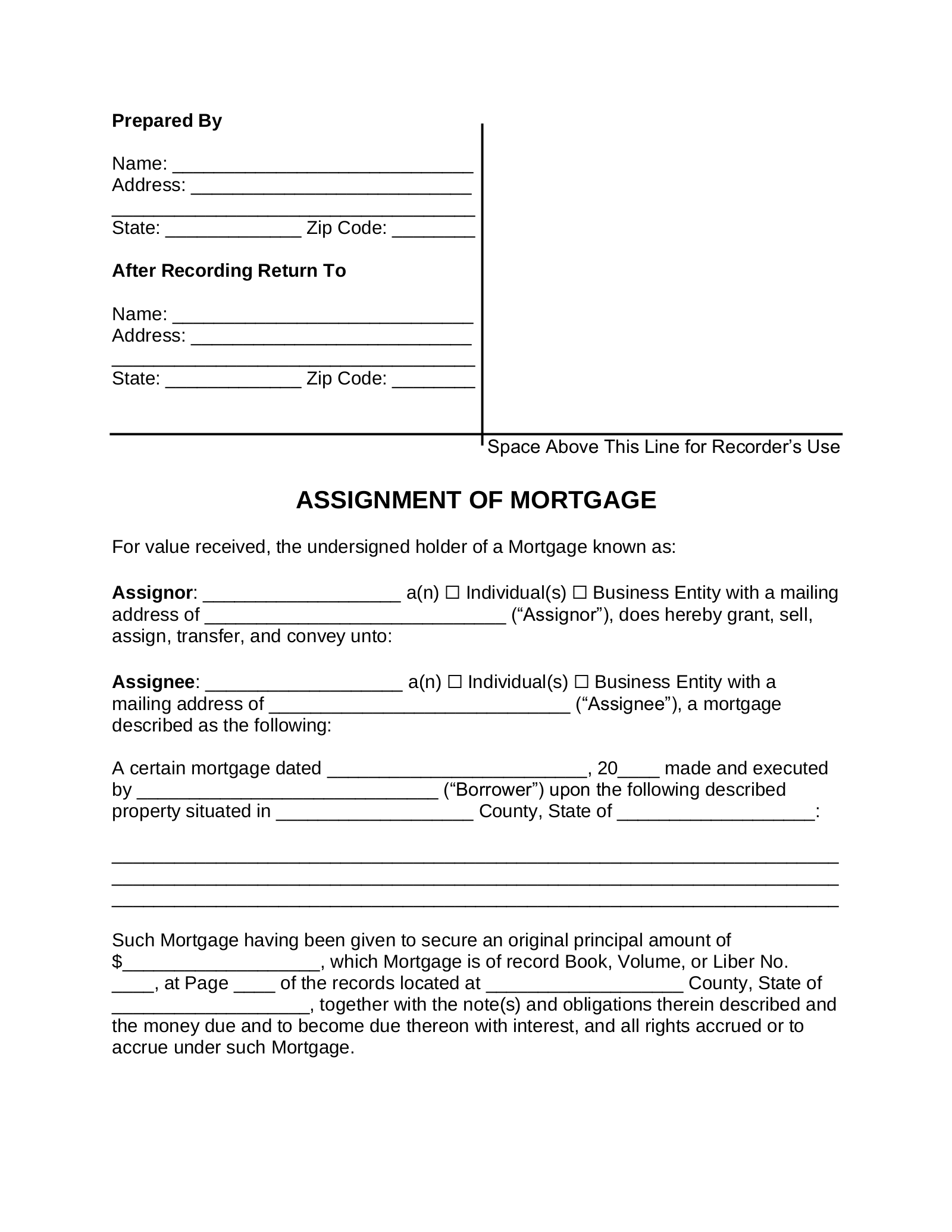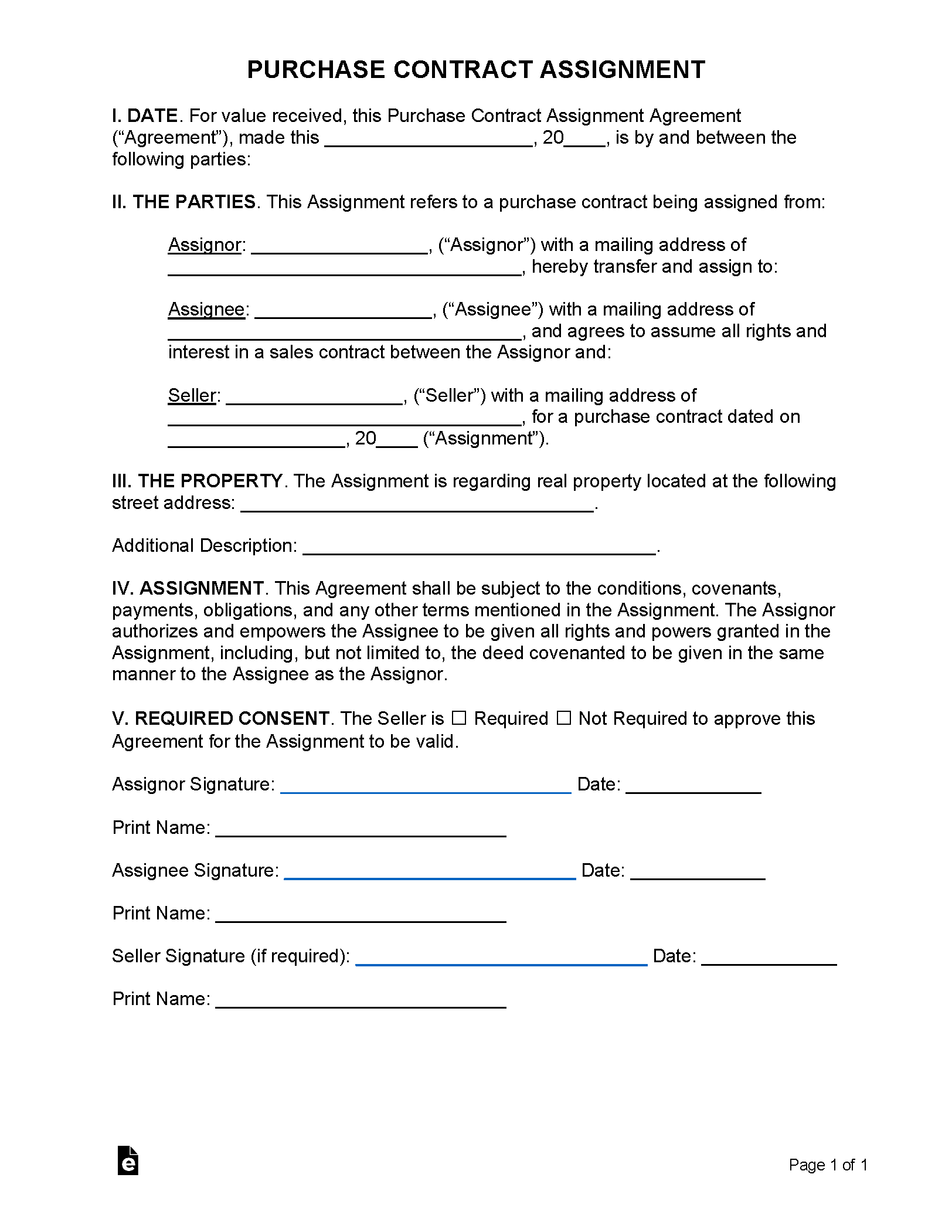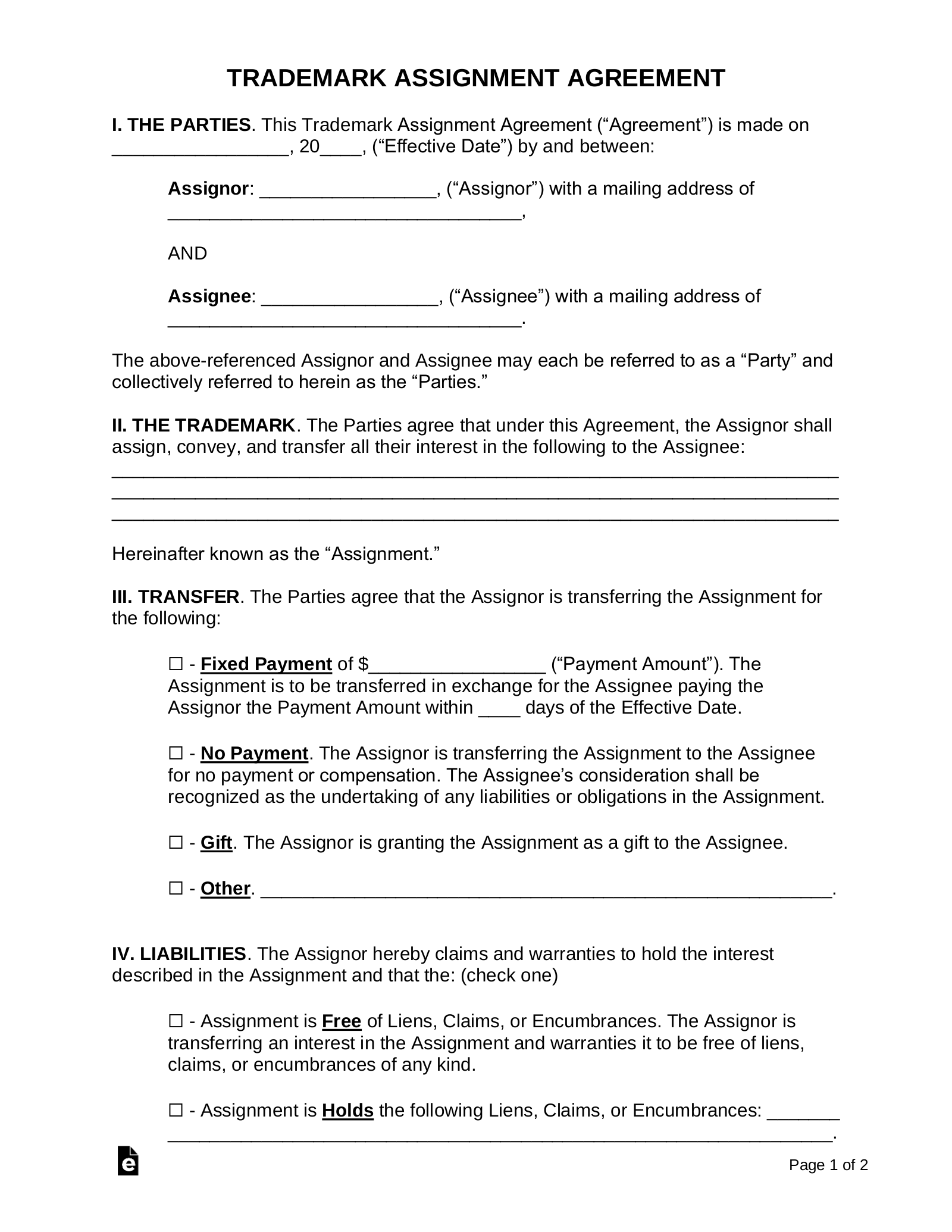Updated June 22, 2023
An assignment agreement transfers ownership interest from an assignor (giving party) to an assignee (receiving party). The interest usually consists of a benefit with any included liabilities. If any payment is required, it should be mentioned in the assignment.
By Type (12)
Table of Contents
- Assignment Agreements: By Type (12)
- How to Assign (4 steps)
- Sample: Assignment Agreement
- How to Write
How to Assign (4 steps)
Step 1 – Make a Deal

The assignor (seller) and the assignee (buyer) should get together to make a verbal agreement or write a letter of intent. This allows the assignee to conduct their due diligence and ensure the property is what the assignor claims to be.
Step 2 – Verify Ownership

In most real estate contracts, for example, a notary public is not required to sign an agreement. Therefore, it’s best to verify with the other party, the landlord or seller, that the contract is valid.
Step 3 – Write the Agreement

Write the assignment agreement including the property details and sales price. Include any other agreed-upon terms and conditions.
Step 4 – Take Control

No matter the type of property (real, personal, etc.) after an agreement is signed, the property should be delivered to the assignee’s possession.
Sample Assignment Agreement
Download: PDF, MS Word, OpenDocument
ASSIGNMENT AGREEMENT
I. THE PARTIES. This Assignment Agreement (“Agreement”) is made on [DATE], (“Effective Date”) by and between:
Assignor: [ASSIGNOR’S NAME], (“Assignor”) with a mailing address of [ASSIGNOR’S MAILING ADDRESS],
AND
Assignee: [ASSIGNEE’S NAME], (“Assignee”) with a mailing address of [ASSIGNEE’S MAILING ADDRESS].
The above-referenced Assignor and Assignee may each be referred to as a “Party” and collectively referred to herein as the “Parties.”
II. THE ASSIGNMENT. The Parties agree that under this Agreement, the Assignor shall assign, convey, and transfer all their interest in the following to the Assignee: [DESCRIBE WHAT IS BEING ASSIGNED]
Hereinafter known as the “Assignment.”
III. TRANSFER. The Parties agree that the Assignor is transferring the Assignment for the following:
☐ – Fixed Payment of $[PAYMENT AMOUNT] (“Payment Amount”). The Assignment is to be transferred in exchange for the Assignee paying the Assignor the Payment Amount within [#] days of the Effective Date.
☐ – No Payment. The Assignor is transferring the Assignment to the Assignee for no payment or compensation. The Assignee’s consideration shall be recognized as the undertaking of any liabilities or obligations in the Assignment.
☐ – Gift. The Assignor is granting the Assignment as a gift to the Assignee.
☐ – Other. [DESCRIBE]
IV. LIABILITIES. The Assignor hereby claims and warranties to hold the interest described in the Assignment and that the: (check one)
☐ – Assignment is Free of Liens, Claims, or Encumbrances. The Assignor is transferring an interest in the Assignment and warranties it to be free of liens, claims, or encumbrances of any kind.
☐ – Assignment is Holds the following Liens, Claims, or Encumbrances: [DESCRIBE]
V. 3RD PARTY APPROVAL. For this Agreement to be in effect: (check one)
☐ – It is REQUIRED for [3RD PARTY’S NAME] (“3rd Party”) to approve this Agreement within [#] days of the Effective Date. If the 3rd Party does not approve this Agreement or fails to sign, this Agreement shall be considered void.
☐ – It is NOT REQUIRED a 3rd Party to approve this Agreement. Upon the execution by both Parties, this Agreement shall be in full force and effect.
VI. ASSUMPTION. The Assignee acknowledges and agrees to assume the transfer and ownership of all liabilities, obligations, and claims that currently exist or may in the future regarding the Assignment. As of the Effective Date, the Assignee agrees to comply with all terms, make all payments, and perform all the conditions, covenants, and any other duties as part of the Assignment.
VII. PARTIES’ REPRESENTATIONS. The Assignee acknowledges that they have a full understanding of the Assignment and the terms of this Agreement. The Assignor further warrants that they own the rights transferred in the Assignment and understand the terms of this Agreement. Both Parties agree to provide and complete any obligations under this Agreement or the Assignment.
VIII. SEVERABILITY. If any term, covenant, condition, or provision of this Agreement is held by a court of competent jurisdiction to be invalid, void, or unenforceable, the remainder of the provisions shall remain in full force and effect and shall in no way be affected, impaired, or invalidated.
IX. GOVERNING LAW. This Agreement shall be governed under the laws located in the State of [STATE OF GOVERNING LAW].
X. WAIVER. The failure of either Party to enforce any provision of this Agreement shall not be deemed a waiver or limitation of that Party’s right to subsequently enforce and compel strict compliance with every provision of this Agreement.
XI. ADDITIONAL TERMS. [ADDITIONAL TERMS]
XII. ENTIRE AGREEMENT. This Agreement constitutes the entire agreement between the Parties. No modification or amendment of this Agreement shall be effective unless in writing and signed by both Parties.
Assignor Signature: ____________________________ Date: ______________
Assignee Signature: ____________________________ Date: ______________
3rd Party Signature (if any): ____________________ Date: ______________
How to Write
Download: PDF, MS Word, OpenDocument
Section I. The Parties
(1) Effective Date Of Assignment. The date when this agreement becomes active must be established. Deliver the calendar date when its effect first obligates the signature Parties to its conditions and terms.

(2) Name Of Assignor. The full name of the Party who intends to release his or her interest or claim must be presented. This Party whether it is an Individual or Business Entity will be known as the Assignor of the claim, interest, and/or property this paperwork discusses.
(3) Mailing Address Of Assignor. Produce a record of the address needed to contact the Assignor by mail. This should be a regularly monitored address that can be considered reliable.

(4) Assignee Name. The Party that wishes to assume the same right to claim or the same interest that the Assignor enjoys with the discussed property and will gain such interest through this paperwork is the Assignee and should be identified by name.
(5) Assignee Mailing Address. The address required to reach the Assignee by mail so that he or she may receive notices and other correspondence required by this agreement should be presented.
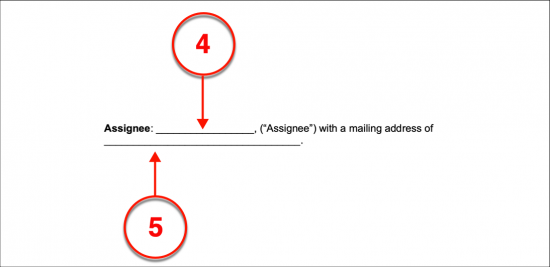
Section II. The Assignment
(6) Details Of Assignment. The assignment being released from the Assignor and being designated to the Assignee must be described. This agreement is versatile allowing nearly any type of assignment of property, a claim on property, a share of the property, or any other interest that may be transferred from one Entity to another however, the type of assignment and the level of interest that will be granted or made available to the Assignee must be documented.

Section III. Transfer
(7) Fixed Payment. The Assignor’s designation or release of property or interest may be contingent upon the receipt of a predetermined payment amount. If so, then this must be declared. Include this condition by marking the first checkbox statement then documenting the amount that the Assignee must pay to the Assignor. Once done, define the maximum number of days from the effective date when this payment must be received.
(8) No Payment. If the Assignor will release interest or property without payment from the Assignee then select the second checkbox option in Section III.
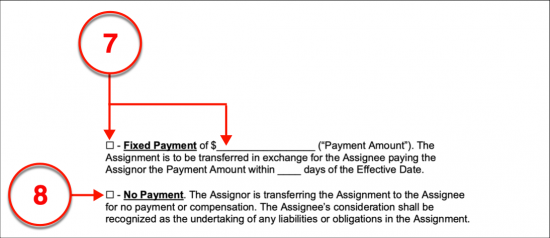
(9) Gift. If the assignment being made is considered a gift of the Assignor to the Assignee then select the third checkbox statement.
(10) Other. There are quite a few other conditions or requirements that can be imposed on the Assignee as well as other reasons for this assignment. If none of the three previous statements are adequate descriptions of such reasons or obligations then select the “Other” checkbox and furnish this information to the space available.
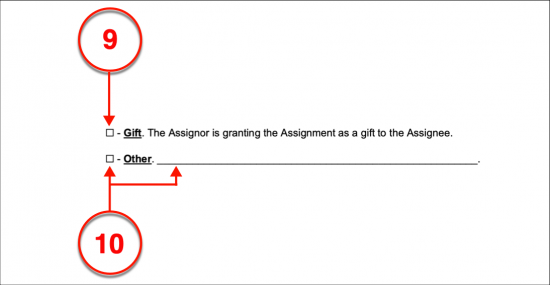
Section IV. Liabilities
(11) Assignment Is Free Of Liens. If the assignment this agreement shall enable will not include an obligation to pay a debt or satisfy an encumbrance then the first statement made in Section IV should be selected by marking the available checkbox.
(12) Assignment Not Free Of Liens. If the concerned assignment has a lien, encumbrance, or debt imposed upon it or there is a claim that must be paid for this assignment to be completed and the Assignee will assume some or all of these obligations with the assignment then select the second checkbox and provide a detailed description of such claims and/or encumbrances.

Section V. 3rd Party Approval
(13) Required Approval. A Third Party (such as a Financial Institution) may need to approve this assignment for it to proceed accordingly. If this is the case, then the “It Is Required” statement should be selected. This status statement must be satisfied with the name of the Third Party whose approval must be obtained and the number of days after the effective date allotted to gain such approval.
(14) No Approval Needed. The second statement in Section V will free both the Assignee and Assignor from seeking a Third Party’s approval to this agreement’s execution. If no approval is required other than the authorizing signature of the Assignor and Assignee then select the second statement.
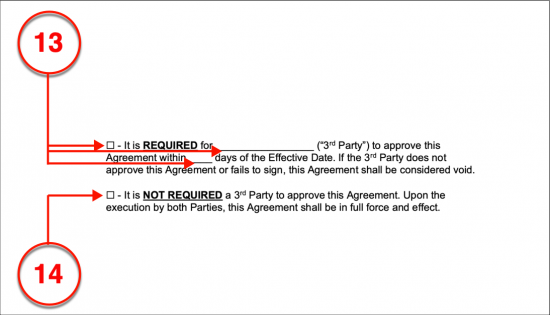
Section IX. Governing Law
(15) State. The State laws that will be applied to this paperwork must be established. Identify the State whose courts shall enforce this document.

Section XI. Additional Terms
(16) Additional Terms. If there are additional requirements or circumstances that relate to this agreement and obligate or restrict either Party, then discuss them in Section XI.

Section XII Entire Agreement
(17) Assignor Signature. The Assignor who is making this assignment must sign this paperwork once it has been completed with the information it requests.
(18) Assignor Signature Date.
(19) Assignee Signature. The Assignee should review all the definitions supplied to this agreement. If he or she will accept the responsibilities and conditions in this document then the Assignee must provide his or her signature.
(20) Assignee Signature Date.

(21) Third Party Signature. If it has been indicated that a Third Party must approve this assignment by signature then the third signature area must be completed by this Party. If this is a Business then a Signature Representative that has been appointed by the Approving Entity must deliver his or her signature on behalf of the concerned Third Party.
(22) Signature Date Of Third Party.


